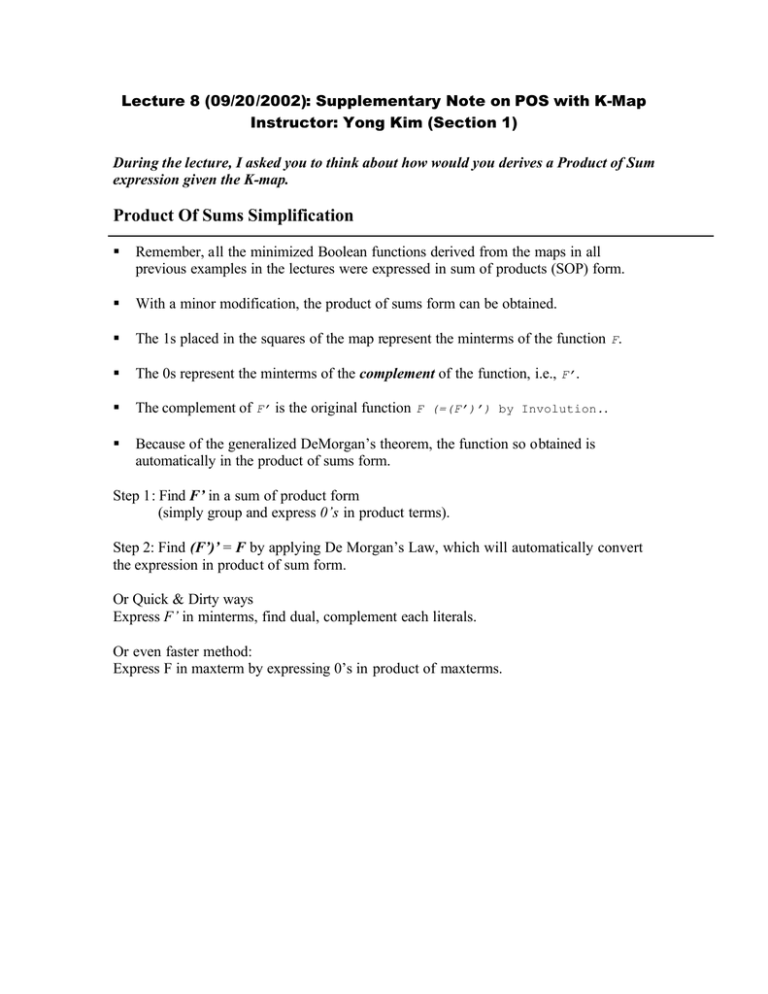Product Of Sums Simplification
advertisement

Lecture 8 (09/20/2002): Supplementary Note on POS with K-Map Instructor: Yong Kim (Section 1) During the lecture, I asked you to think about how would you derives a Product of Sum expression given the K-map. Product Of Sums Simplification § Remember, all the minimized Boolean functions derived from the maps in all previous examples in the lectures were expressed in sum of products (SOP) form. § With a minor modification, the product of sums form can be obtained. § The 1s placed in the squares of the map represent the minterms of the function F. § The 0s represent the minterms of the complement of the function, i.e., F’. § The complement of F’ is the original function F (=(F’)’) by Involution.. § Because of the generalized DeMorgan’s theorem, the function so obtained is automatically in the product of sums form. Step 1: Find F’ in a sum of product form (simply group and express 0’s in product terms). Step 2: Find (F’)’ = F by applying De Morgan’s Law, which will automatically convert the expression in product of sum form. Or Quick & Dirty ways Express F’ in minterms, find dual, complement each literals. Or even faster method: Express F in maxterm by expressing 0’s in product of maxterms. Problem: Simplify the Boolean function F(A,B,C,D) = Σ(1, 3, 4, 5, 6, 12, 13, 14) in both sum of products and product of sums form. F(A,B,C,D) = Σ(1, 3, 4, 5, 6, 12, 13, 14) AB\CD A’B’ A’B AB AB’ C’D’ 0 1 1 0 C’D 1 1 1 0 CD 1 0 0 0 CD’ 0 1 1 0 sum of products (what we have been working on most of time) grouping of 1’s Make a group of two by grouping m1 and m 3 = A’B’D. Make a group of four by grouping m4, m5, m12, and m13 = BC’. Make a group of four by grouping m4, m12, m 6, and m14 = BD’. read the terms from each group and sum them F(A,B,C,D) = A’B’D + BC’ + BD’ product of sums Step 1 – Find F’ by grouping 0’s, expressing 0’s (not 1’ Make a group of four by grouping m0, m2, m8, and m 10 = B’D’. Make a group of four by grouping m8, m9, m11, and m10 = AB’. Make a group of two by grouping m7 and m 15 = BCD. read the terms from each group and sum them F’(A,B,C,D) = B’D’ + AB’ + BCD Step 2 – apply DeMorgan’s theorem (F’)’ = (B’D’ + AB’ + BCD)’ F(A,B,C,D) = (B + D)(A’ + B)(B’ + C’ + D’) 5-variable K-map example: Simplify the Boolean function F(A,B,C,D,E) = Σ(0, 2, 4, 6, 16, 18, 20, 22, 26, 30). BC\DE B’C’ B’C BC BC’ D’E’ 1 1 0 0 D’E 0 0 0 0 DE 0 0 0 0 DE’ 1 1 0 0 DE 0 0 0 0 DE’ 1 1 1 1 A’ BC\DE B’C’ B’C BC BC’ D’E’ 1 1 0 0 D’E 0 0 0 0 A Step 1 – grouping Make a group of eight by grouping m0, m4, m 2, m6, m16, m 20, m18, and m22 = B’E’. Make a group of four by grouping m18, m22, m30, and m26 = ADE’. Step 2 – read the terms from each group and sum them F(A,B,C,D,E) = B’E’ + ADE’



